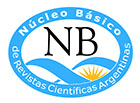Argentina’s green export potential: an analysis of the green production space
DOI:
https://doi.org/10.59339/de.v63i241.649Keywords:
Sustainable Development, Green Exports, Climate Change, ArgentinaAbstract
Is it possible to harmonize a green export development strategy with the acceleration of economic growth in Argentina, and towards which sectors should public policy efforts be directed in order to achieve this? To answer these questions, this article constructs the “Green” product-space at 6 digits of disaggregation of the harmonized system of international trade and analyzes the economic complexity associated with each of its products, as well as its connections with the already competitive sectors of the country. In this way, the economic benefits associated with products that directly provide environmental services or are key to activities that reduce gas emissions can be weighed. The main results are summarized as follows: i) green products, in general, are complex products and their development would accelerate the economic growth of the countries; ii) however, the green products closest to the current productive capacities of Argentina are of low complexity and with low contribution to economic growth; iii) these results would justify the exploration of costs and benefits of carrying out productive policies that maximize the complexity of the green export basket to be developed and minimize the productive effort to achieve it. To this end, different selection criteria are proposed, which result in 30 products that could be the starting point for a green export development strategy for a given country.
Downloads
References
Acemoglu, D., Aghion, P., Bursztyn, L., & Hemous, D. (2009). The Environment and Directed Technical Change. doi:https://doi.org/10.3386/w15451
Aghion, P., Hemous, D., & Veugelers, R. (2009). No Green Growth without Innovation. Bruegel Policy Brief - 2009/07. Recuperado de https://lirias.kuleuven.be/retrieve/114088
Aghion, P., Hepburn, C., Teytelboym, A., & Zenghelis, D. (2019). Path Dependence, Innovation and the Economics of Climate Change. Handbook on Green Growth. doi:https://doi.org/10.4337/9781788110686.00011
Balassa, B. (1965). Trade liberalisation and “revealed” comparative advantage. The Manchester school, 33(2), 99-123. doi:https://doi.org/10.1111/j.1467-9957.1965.tb00050.x
Belmartino, A. (2022). Green & non-green relatedness: challenges and diversification opportunities for regional economies in Argentina. Recuperado de https://ideas.repec.org/p/nmp/nuland/3697.html
Brest López, C., García Díaz, F., & Rapetti, M. (2019). El desafío exportador de Argentina. Recuperado de https://www.cippec.org/publicacion/el-desafio-exportador-de-argentina/
Bril Mascarenhas, T., Freytes, C., O’Farrell, J., & Palazzo, G. (2020a). Qué es el desarrollo y cómo pensarlo. Documento de trabajo N°1. Fundación para el Desarrollo Argentino (Fundar). Recuperado de https://www.fund.ar/publicaciones/
Bril Mascarenhas, T., Gutman, V., Dias Lourenco, M. B., Pezzarini, L., Palazzo, G., & Anauati, M. V. (2021). Políticas de desarrollo productivo verde para la Argentina. Buenos Aires: Fundar.
Cantore, N., & Cheng, C. (2018). International trade of environmental goods in gravity models. Journal of environmental management, (223), 1047-1060. doi:https://doi.org/10.1016/j.jenvman.2018.05.036
Felipe, J., Kumar, U., Abdon, A., & Bacate, M. (2012). Product complexity and economic development. Structural Change and Economic Dynamics, 23(1), 36–68. doi:https://doi.org/10.1016/j.strueco.2011.08.003
Fraccascia, L., Giannoccaro, I., & Albino, V. (2018). Green product development: What does the country product space imply? Journal of Cleaner Production, 170 (January), 1076–88. doi:https://doi.org/10.1016/j.jclepro.2017.09.190
Hallegatte, S., Heal, G., Fay, M., & Treguer, D. (2012). From Growth to Green Growth - a Framework. National Bureau of Economic Research. doi:https://doi.org/10.3386/w17841
Hamwey, R., Pacini, H., & Assunção, L. (2013). Mapping Green Product Spaces of Nations. Journal of Environment & Development, 22 (2), 155–168. doi:https://doi.org/10.1177/1070496513482837
Hausmann, R., & Hidalgo, C. A. (2011). The Network Structure of Economic Output. Journal of Economic Growth, 16 (4), 309–342. Recuperado de http://www.tinyurl.com/y4yeros7
Hausmann, R., Hidalgo, C. A., Bustos, S., Coscia, M., & Simoes, A. (2014). The Atlas of Economic Complexity: Mapping Paths to Prosperity. MIT Press, 482–487. Recuperado de https://growthlab.cid.harvard.edu/atlas-economic-complexity
Hickel, J., & Kallis, G. (2020). Is Green Growth Possible? New Political Economy, 25 (4), 469–86. doi:https://doi.org/10.1080/13563467.2019.1598964
Hidalgo, C. A., & Hausmann, R. (2009). The Building Blocks of Economic Complexity. Proceedings of the National Academy of Sciences of the United States of America, 106 (26): 10570–10575. doi:https://doi.org/10.1073/pnas.0900943106
Hidalgo, C. A., Klinger, B., Barabási, A.-L., & Hausmann, R. (2007). The Product Space Conditions the Development of Nations. Science. doi:https://doi.org/10.1126/science.1144581
Howse, R., & Van Bork, P. B. (2006). Options for Liberalising Trade in Environmental Goods in the Doha Round. Geneva: International Centre for Trade and Sustainable Development. Recuperado de https://www.researchgate.net/publication/239808917_Options_for_Liberalising_Trade_in_Environmental_Goods_in_the_Doha_Round
Kallis, G. (2011). In Defence of Degrowth. Ecological Economics: The Journal of the International Society for Ecological Economics, 70(5), 873–880. doi:https://doi.org/10.1016/j.ecolecon.2010.12.007
Kallis, G., Kerschner, C., & Martinez-Alier, J. (2012). The Economics of Degrowth. Ecological Economics: The Journal of the International Society for Ecological Economics, 84 (December), 172–180. doi:https://doi.org/10.1016/j.ecolecon.2012.08.017
Marín, A., & Goya, D. (2021). Mining - The dark side of the energy transition. Environmental Innovation and Societal Transitions, 41, 86-88. doi:https://doi.org/10.1016/j.eist.2021.09.011
Mealy, P., & Teytelboym, A. (2020). Economic Complexity and the Green Economy. Research Policy, April, 103948. doi:http://dx.doi.org/10.2139/ssrn.3111644
OECD. (2009). OECD 2009 Ministerial Meeting Conclusions. Organisation for Economic Cooperation and Development. The OECD Observer; Paris. Paris, France, Paris: Organisation for Economic Cooperation and Development (OECD). Recuperado de https://search.proquest.com/openview/4c7ffee93934ab0ac4d1b150f4b06985/1?pq-origsite=gscholar&cbl=35885
OECD (2011). OECD Green Growth Studies Towards Green Growth. OECD Publishing.
Porter, M. E., & Linde, C. V. (1995). Toward a new conception of the environment-competitiveness relationship. Journal of Economic Perspectives, 9(4), 97-118. doi:https://doi.org/10.1787/9789264111318-en
Ramos, M. P. (2018). El comercio de bienes ambientales una evaluación en equilibrio general computado para la argentina a nivel de producto (HS6). Universidad de Buenos Aires. Facultad de Ciencias Económicas. Instituto Interdisciplinario de Economía Política de Buenos Aires; Documentos de Trabajo del IIEP, 33, 11-2018, 1-40. Recuperado de http://iiep-baires.econ.uba.ar/publicacion/478
Ramos, M. P., Chisari, O., & Vila Martínez, J. P. (2017). Scale, Technique and Composition Effects of CO2 Emissions under Trade Liberalization of EGS: A CGE Evaluation for Argentina. World Academy of Science, Engineering and Technology; International Journal of Environmental and Ecological Engineering, 11(7), 7-2017, 1-5. Recuperado de https://waset.org/Publication/scale-technique-and-composition-effects-of-co2-emi
Downloads
Published
How to Cite
Issue
Section
License

This work is licensed under a Creative Commons Attribution-NonCommercial-ShareAlike 4.0 International License.
Manuscript acceptance by the Journal implies the simultaneous non-submission to any other journal or publishing house, and the non-exclusive transmission of the author´s patrimonial rights in favor of the editor, who allows the post-print version use, under the Licencia Creative Commnos Atribución-NoComercial-Compartir Obras Derivadas Igual 4.0 Internacional (CC-BY-NC.SA 4.0) (http://creativecommons.org/licences/by-nc-sa/4.0/deed.es). Articles can be shared, copied, distributed, modified, altered, transformed into a derivative work, executed and publicly communicated, provided a) the authors and the original publication (Journal, Publisher and URL) are mentioned, b) they are not used for commercial purposes, c) the same terms of the license are maintained.
It is hereby stated that the mentioned manuscript has not been published and that it is not being printed in any other national or foreign journal.
The authors hereby accept the necessary modifications, suggested by the reviewers, in order to adapt the manuscript to the style and publication rules of this Journal.









